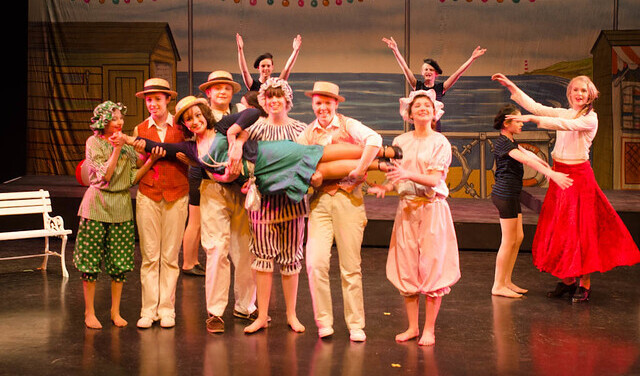Involving young people in drama and theatre productions creates unforgettable experiences for the young people, the practitioners, and audiences while building essential life skills in the young people at the same time. As a drama teacher, starting a youth theatre is no mean feat, but it is incredibly rewarding. I’ve seen first-hand how active participation in every aspect of theatre can significantly enhance students’ learning, creativity, and confidence.
In some cases, being involved in a youth theatre has been a stepping stone to a career in theatre or the arts. In others, it’s just been about having fun with friends and doing something amazing. And for a few, it literally saved their life! This article provides practical, step-by-step guidance to start a youth theatre, ensuring it becomes a fun, educational, and deeply rewarding experience for all involved.

Senior Youth Theatre production of “West Side Story”
Step 1: Define Clear Objectives
Setting clear objectives right from the start is crucial. Knowing exactly what you aim to achieve helps students and teachers alike stay focused and motivated. Your objectives could include developing acting skills, improving confidence, fostering teamwork, or simply creating a fun, educational environment and putting on a show! The spirit of “Let’s put on a show” still lives on long after the Mickey Rooney and Judy Garland films, where the characters rally together to stage a performance and inevitably save something or someone!
Key Questions to Guide Objectives:
- Should we perform a specific play, musical, or devise our own production?
- What type of production aligns best with my students’ interests and abilities?
- How can I balance structured learning with creative freedom? (Do I need to?)
- What specific skills should students gain?
- How can roles be structured so everyone feels valued and involved?
Clearly sharing these objectives builds enthusiasm and aligns everyone’s efforts towards a common goal.

Senior Youth Theatre production of “The Boyfriend”
Step 2: Choose the Right Production
Selecting the right production can significantly impact student engagement. Many young people are attracted by the excitement of putting on a show. Decide whether a straight play or musical is most appropriate based on students’ skills, available resources, and interest levels. I don’t advise choosing the youth version of “Les Miserables” as your first performance! Choose something that you know you can cast and stage with the resources and people you have.
Considerations When Choosing a Production:
- Student interests and skill levels (acting, singing, dancing, technical)
- Availability of scripts and licensing requirements – not all shows are available to licence depending on whether there are current professional versions running
- Required resources (props, costumes, sets, technical equipment)
- Practical logistics (rehearsal and performance venues)
- Accessibility and inclusivity of the chosen material
- Funding and costs
Step 3: Decide on Funding and Participation Policies
Determining your approach to funding and participation is essential. Is this a business you are setting up or a not-for-profit organisation? What will the leadership look like and who will have creative and financial control? You may need to start a charity or other business format, but you will need to consider the pros and cons of each and tailor it to your own situation.
When it comes to funding, consider whether you’ll charge fees for participation or if the theatre group will be free, and clearly communicate how the group will be funded (e.g., grants, sponsorship, donations, or ticket sales). In my experience, you will need a little bit of all income sources to make your youth theatre sustainable. Additionally, decide whether your theatre group will be open to everyone or if auditions will be required.
Funding and Participation Questions:
- Will students need to pay to participate, or will it be free?
- How will your theatre group secure funding?
- Will there be auditions, or will participation be open to all?
These decisions shape the inclusivity, accessibility, and sustainability of your theatre group.

Senior Youth Theatre production of “Billy”
Step 4: Organise Practical Requirements
Successful theatre productions rely on effective organisation and logistics, and the one thing you can’t do is ‘do it alone!’ Teamwork is essential, and getting your friends, family, co-workers or employees on board is crucial to your success. Build a strong team and make use of their knowledge and expertise, be that in stage management, costumes, sourcing funding or marketing.
Key Practical Considerations:
- Identify and secure rehearsal and performance venues early. Many professional venues are booked up 2-3 years in advance. Local venues may be easier to start with. You may not even want a professional theatre for your first production, instead going for a rehearsed reading or a scaled-back, simple production.
- Ensure sufficient adult supervision and support (including backstage and technical roles).
- Check out any rules requiring chaperones and safeguarding requirements. You will need to have a written child protection policy available to show participants and venues.
- Complete all necessary safeguarding procedures, such as DBS checks, to ensure student safety.
- Comply with local data protection laws.
- Establish a clear rehearsal schedule that accommodates both students and supervising adults.
Step 5: Start Small
Begin by easing students into theatre through small, interactive activities. These activities reduce performance anxiety, encourage bonding, and introduce basic theatre concepts comfortably.
Activities to Kick-Start Engagement:
- Ice-breaker games to build comfort and camaraderie
- Short improvisation exercises or workshops on basic acting skills
- Group brainstorming sessions on themes and staging
- Rehearsed readings and one act plays
These initial activities lay the groundwork for deeper involvement later on in larger productions.

Junior Youth Theatre production of “Bugsy Malone”
Step 6: Design Engaging, Inclusive Roles
Theatre isn’t just for actors. Every aspect – from set and costume design to technical roles – offers valuable learning opportunities and there will be young people who want to get involved in these aspects too. It’s important to design roles accessible to all students, ensuring everyone can contribute meaningfully.
Role Opportunities:
- Stage management
- Creative art and set-design tasks
- Choreography and movement
- Musical directors and musicians
- Props creation and management
- Costumes and make-up
- Technical support roles (lighting, sound, filming or special effects)
- Script adjustments and collaborative dialogue sessions
- Marketing and advertising
- Front-of-house
- Administration and fund-raising
Encouraging students to explore diverse roles helps them discover new interests and talents.
Step 7: Collaboration and Teamwork
Theatre thrives on collaboration. Encouraging teamwork helps students understand the value of every role and develops mutual respect and stronger creative outcomes. We always put great store on respecting ALL roles and encouraging the students to do the same. If you were the lead actor in the show, you were still expected to help with the get-in and get-out and sweep the stage if it was needed!
Building Effective Teamwork:
- Assign small teams specific responsibilities, such as scene rehearsals or prop/costume creation
- Facilitate sessions for constructive peer feedback
- Structure rehearsals to emphasise mutual support and clear communication
- Run theme-focused workshops to strengthen understanding and unity
- Nip any prima donna behaviour in the bud!!
Collaboration empowers students, making them more willing to trust each other and take creative risks.

Senior Youth Theatre production of “Les Miserables”
Step 8: Incorporate Planning and Regular Feedback
Effective planning and structured feedback sessions ensure that everyone remains focused and can adapt quickly to new ideas or challenges.
Planning and Feedback Tips:
- Schedule frequent check-ins to track progress and share suggestions. This may be with a committee or management group that helps run the youth theatre
- Maintain clear agendas for planning meetings
- Set up protocols so that everyone knows what to do in certain situations
- Establish accessible, open channels for student feedback and ideas
A well-organised approach reinforces a sense of shared responsibility and achievement.
Step 9: Cultivate a Supportive Environment
Creating a positive, supportive atmosphere is fundamental to success in youth theatre. Students must feel safe to express their ideas, take creative risks, and learn from constructive feedback without fear of judgment.
Ways to Create Support:
- Follow your passion and encourage that in everyone
- Understand and welcome diversity
- See everyone for the brilliant beings they are and cultivate tolerance and acceptance
- Offer different experiences and encourage students to try new things
- Promote open dialogue and encourage every student to contribute
- Provide feedback positively and constructively
- Rotate leadership opportunities among students
- Ensure rehearsal spaces are comfortable and free from distractions
A nurturing environment enhances both student confidence and the overall quality of the production.

Senior Youth Theatre production of “Pendragon”
Step 10: Balance Consistency with Flexibility
Maintaining consistency in rehearsals helps students build confidence and familiarity with their roles. At the same time, remain flexible and open to new ideas, allowing experimentation and creativity to flourish.
Balancing Routine and Innovation:
- Stick to a regular rehearsal schedule to build routine and reliability
- Encourage creative experimentation during rehearsals
- Regularly review progress and be open to adjustments
- Celebrate small successes to maintain enthusiasm and motivation
- Vary your shows, venues, and production values, and always be open to new suggestions
This balanced approach ensures sustained engagement and dynamic creativity.
Final Thoughts
A successful youth theatre nurtures confidence, creativity, practical skills, and community spirit in the young people who attend. Clear objectives, engaging roles, and supportive and challenging environments combine to create transformative theatrical experiences for all.
Your passion and dedication in guiding young talent not only enhance performances but it can also inspire lifelong creativity and collaboration. Enjoy every moment of this enriching journey, and keep celebrating the joy theatre brings to your young students’ lives.

Junior Youth Theatre production of “A Midsummer Night’s Dream”
My Own Personal Experience of Starting a Youth Theatre
I started a youth theatre in the UK in the year 2000, and ran it for over 23 years under the names DAPA and Phoenix Creative Arts. Our youth theatre was aimed at students aged 12 – 20, but we also had a junior youth theatre for students from 5-12. Over that time, we put on numerous productions in a variety of different professional and local venues, including performances at Her Majesty’s Theatre in the West End of London as part of a group charity performance. I started the youth theatre from scratch, had 5 students in our first summer school and soon had over 400 students across 3 schools that we opened up.
I tell you this because I want you to know that my knowledge comes from 23+ years of doing the legwork!! It was truly one of the most amazing periods of my life and I am very proud of my students and the work we produced together. Several of my students went on to star in West End productions, including Harry McEntire and Ed Judge in the London cast of “Spring Awakening”, and Luke Brady who starred in “Prince of Egypt” as Moses in the West End, and is currently about to play Hercules in the West End version of that.
There were also many others who did not go on to professional careers, but whose ‘thank you’ notes, performances, shared good times and bad times, I will treasure forever. I thank you all.
I’ve put a few photos of some of our productions throughout this article – fun times!
Gail

Senior Youth Theatre production of “Cats”
Related articles
Basic Acting Techniques For Beginners
Sunday Shakespeare: Excellent Lessons From The Bard: 2 – To Be Or Not To Be



This is a fantastic guide for anyone looking to start a youth theatre program! The step-by-step approach is clear and practical. I especially like the emphasis on finding the right space and building a supportive community. From my experience, one of the biggest challenges is getting enough engagement from parents and volunteers. How do you recommend handling that aspect, especially in the early stages? The tips you’ve provided would definitely help anyone looking to make youth theatre a success.
Hi Jacob, Thanks for your kind comments. I’m so pleased that you found the article useful with the step-by-step approach. I agree that getting people on your side when you start out can be difficult, but that’s why you can start small and build up. I’ve found that when you allocate parts in the play, you can usually then appeal for help from parents and carers who are only too willing to help their children in some way. I have also employed people in the past too, especially sound and lighting designers when I’ve used professional theatres, but I have set up the lights and tech things in the smaller venues myself. The thing is… if you don’t ask, you don’t get, so there’s no harm in putting out a request to seven! 🙂
This article offers such a valuable and practical roadmap for anyone thinking about launching a youth theatre program. The 10 steps are laid out clearly, making what could feel like an overwhelming project feel entirely achievable. I especially appreciated the emphasis on building community partnerships and creating a safe, inclusive space—those elements can truly make or break a program.
In my own experience helping to start a small community youth theatre group, the biggest challenge was securing a consistent rehearsal space. We ended up partnering with a local library that had a multipurpose room, and that collaboration turned into a long-term win for both sides. The tips in this article about community outreach and securing a venue really hit home for me.
I also liked the point about defining a mission early on. That was something we initially overlooked, and once we clarified our goals, it helped attract like-minded volunteers and participants.
This is a fantastic resource that I wish I’d had when we first got started!
Hi Laura. Thank you so much for your kind comments and it’s lovely to know that you think the post is useful to anyone wanting to start a youth theatre. When I started, I had lots of questions, and I learned a lot by trial and error in the early days. That’s why I’d like to help people by sharing my experiences. I agree that finding a venue for rehearsals that is affordable and regularly available can be a problem. We used church halls, village halls, theatres, school halls and outside in a field once! One tip I found here is that the local authorities that we have in the UK quite often have a list of ‘halls for hire’ or libraries do as well so they can be good places to start looking. With the advent of the internet which was only in its infancy when I started, it should be easier to find and locate suitable places. The trick is – don’t give up – have a bit of faith and something will turn up!